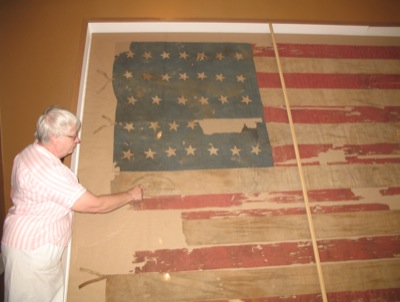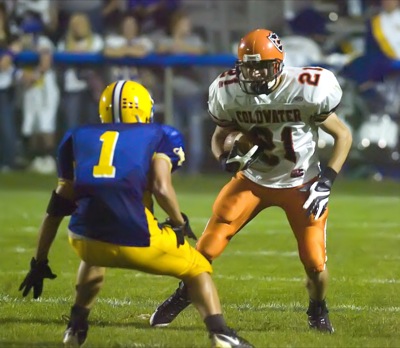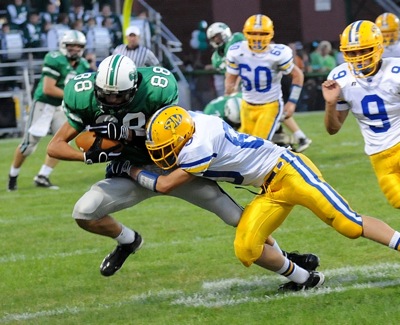Saturday, September 19th, 2009
Faded Old Glory shines again as New Bremen community treasure
By Margie Wuebker

Photo by Margie Wuebker/The Daily Standard
Delores Stienecker, a member of the New Bremen Historic Association and curator of the group's museum, admires the restored Civil War flag the men of Auglaize County's Company C carried into battle. The flag is on display at The Bicycle Museum of New Bremen.
NEW BREMEN - If the faded red, white and blue flag could talk, what tales it would tell about a war pitting North against South and in some cases brother against brother.
The hand-stitched cotton and wool Civil War flag accompanied the men of Company C into battles from the Tennessee Valley to Savannah, Ga., and General William Tecumseh Sherman's infamous march to the sea.
Fresh from lengthy restoration work, the flag now occupies a place of prominence at The Bicycle Museum of Ohio following a recent dedication ceremony on the banks of the nearby Miami and Erie Canal.
"This is a community treasure," proclaims Delores Stienecker, a member of the New Bremen Historic Association and curator of the group's museum. "More than 40 of the village's sons were part of Company C of the 37th Ohio Volunteer Infantry Regiment."
Historian Mark Bernstein explains in his book "Company C" that Civil War armies were built from 100- to 110-member units with 10 of these companies comprising a regiment. The men of Company C came from throughout Auglaize County. They were coopers, tailors, tinners, butchers, cigar makers, blacksmiths, clerks, laborers and farmers.
The New Bremen enlistees departed the first week of September in 1861 for Camp Brown near Cleveland. The lavish send-off meal included speeches and the presentation of a large flag measuring 6 feet, 6 inches by 13 feet, 8 inches.
Townswomen, reportedly led by Maria Anna Fricke Langhorst, stitched the double-seamed flag over the course of many weeks. Stienecker believes the wool likely came from the former Kuenzel Woolen Mill in the community.
"It was certainly a work of love," she says. "I would imagine the women gathered at a central location like a church or a hall of some sort to complete the ambitious project. They certainly needed lots of elbow room."
With needles, thimbles and spools of thread, the women continued a popular practice of providing a large banner for the hometown soldiers. It had to be large so soldiers separated in the heat of battle could find their units.
George Wilhelm "William" Schulenberg, a hack driver by profession, served as flag bearer - a dangerous assignment given a position at the front of the ranks.
Schulenberg was shot twice while carrying the banner - through the hat and through his blouse or shirt without sufficient injuries to stay him from his appointed task.
The flag did not escape the ravages of bullets and shrapnel. Stienecker points to a neatly darned area amid the red and white stripes.
"I can almost imagine one of the soldiers carefully stitching the bullet hole closed by the light of a campfire," she says. "The men revered their company flag and took whatever steps necessary to protect it."
Schulenberg brought the flag home after the war and it remained in his family's possession for nearly a century. In 1975, Ray Knipple donated the flag to the historic association. It remained in a small wooden box with an inspection window for many more years.
"When I became museum curator, I dreamed of having the old flag restored," Stienecker says. "The glass had broken and the bundled flag already was in very fragile condition."
New Bremen resident James Dicke II, who had a relative killed at the battle of Vicksburg, made arrangements for restoration and assumed the undisclosed price. The meticulous work began in 2003 in the Textile Conservation Laboratory at the Cathedral of St. John the Divine in New York City. Rehydration preceded unfurling of the flag to lessen further damage to the brittle fabric that had fallen into 11 pieces. Laboratory director Marlene Eidelheit likened the task to unwrapping a mummy.
"The people there commented they could smell gun powder as the flag was unrolled," Stienecker says. "They also found some dried flowers as well as an attached cloth banner reading 'Presented to the Volunteers of New Bremen by the citizens of New Bremen.' We knew such a banner existed but we did not know where."
Restoration specialists discovered evidence of "souveniring" as patches had been cut from the flag and apparently buried with fallen soldiers. Someone carefully clipped three of the 34 stars - an honor accorded to the dead of high-ranking importance.
The flag, which still bears evidence of oil stains and heavy wear, now hangs in a glass case sewn into place between layers of netting. The red stripes have faded and the soiled stripes are no longer white. Remarkably, the deep blue field of stars remains brilliant but the specialists were unable to remove the wrinkles from years of haphazard storage.
"This is something people and especially school children need to see," Stienecker says. "Standing here and looking at the flag makes you aware of the dedication of the young men who marched off to war long ago. Some came home while others made the ultimate sacrifice."




